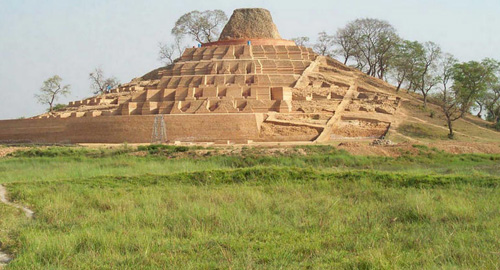Kesariya - Kesaputta OR Religious stupa OR Renowned Buddhist Spot
Kesariya is a small city in Bihar, and world-famous, especially amongst the Buddhist circles, for the Kesaria Stupa (perhaps) the largest stupa in the entire world (104 ft). Located in the Champaran (east) District, at a distance of nearly 110 km from the capital city of Patna, this one of the most well-known Buddhist destinations is situated at the corner of Gopalganj, Chhapra and Muzaffarpur Districts.
Many travel & tours operators covering the various Buddhist spots of the state make it a point to include Kesariya in the travel itineraries that they prepare for the religiously inclined visitors who wish to tour the many Buddhist tourist places of the region.
Believed to have been built by King Ashoka, Kesariya was known as Kesaputta during the time of the Lord Buddha. It was a township of the Kosalans and the abode of the Kalamas. Lord Buddha once stayed there, and he preached the Kesaputtiya Suttas during that time.
Kesariya Stupa acts as a superb model of Buddhist architecture and archaeological preservation. Several exciting stories are related with Kesaria. One such story suggests that Lord Buddha spent a night at this place prior to his Nirvana and offered his begging-bowl to the Lichhivis.
The wonderful stupa tells people of Buddha’s kindly approach towards people, irrespective of caste and creed. The excavations carried out at the spot of the stupa have thrown up some important findings, including Islamic coins, copper and terracotta items, arrow heads, decorated bricks and earthen lamps. Numerous images of the Lord Buddha in "Bhoomi Sparsh Mudra" and other sitting poses have also been discovered here.
Nearby Attraction
Goplaganj : Located in the neighborhood of Kesaria, Goaplganj is a district and famed for the historically renowned tourist places of Thawe, Hathwa and Manjhagarh. While Thawe is well-known religious and cultural spot that houses an old Hindu religious shrine dedicated to the Goddess Durga and the huge fair which is held here every year during the March and April months, Dighwa-Dubauli is a very old place with two astonishing pyramidal-shaped mounds said to have been built by Chero-Chai, or the Cheros - an aboriginal race who at one time were quite dominant in this region.
|
Enquire for any of our hotels |
Please fill the query form to get the tariff/packages rates & Reservation. |
|
|
|
 |
|

